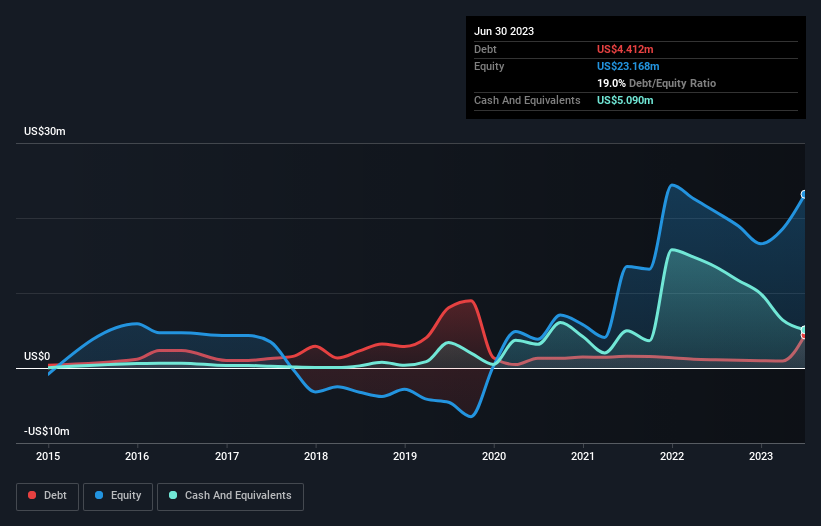Howard Marks put it nicely when he said that, rather than worrying about share price volatility, 'The possibility of permanent loss is the risk I worry about... and every practical investor I know worries about.' It's only natural to consider a company's balance sheet when you examine how risky it is, since debt is often involved when a business collapses. As with many other companies Sadot Group Inc. (NASDAQ:SDOT) makes use of debt. But should shareholders be worried about its use of debt?
When Is Debt A Problem?
Debt assists a business until the business has trouble paying it off, either with new capital or with free cash flow. If things get really bad, the lenders can take control of the business. However, a more common (but still painful) scenario is that it has to raise new equity capital at a low price, thus permanently diluting shareholders. By replacing dilution, though, debt can be an extremely good tool for businesses that need capital to invest in growth at high rates of return. When we examine debt levels, we first consider both cash and debt levels, together.
View our latest analysis for Sadot Group
How Much Debt Does Sadot Group Carry?
You can click the graphic below for the historical numbers, but it shows that as of June 2023 Sadot Group had US$4.41m of debt, an increase on US$1.10m, over one year. However, it does have US$5.09m in cash offsetting this, leading to net cash of US$678.0k.

A Look At Sadot Group's Liabilities
Zooming in on the latest balance sheet data, we can see that Sadot Group had liabilities of US$45.5m due within 12 months and liabilities of US$3.65m due beyond that. Offsetting this, it had US$5.09m in cash and US$47.5m in receivables that were due within 12 months. So it actually has US$3.44m more liquid assets than total liabilities.
This surplus suggests that Sadot Group has a conservative balance sheet, and could probably eliminate its debt without much difficulty. Simply put, the fact that Sadot Group has more cash than debt is arguably a good indication that it can manage its debt safely. When analysing debt levels, the balance sheet is the obvious place to start. But ultimately the future profitability of the business will decide if Sadot Group can strengthen its balance sheet over time. So if you want to see what the professionals think, you might find this free report on analyst profit forecasts to be interesting.
Over 12 months, Sadot Group reported revenue of US$529m, which is a gain of 4,239%, although it did not report any earnings before interest and tax. When it comes to revenue growth, that's like nailing the game winning 3-pointer!
So How Risky Is Sadot Group?
By their very nature companies that are losing money are more risky than those with a long history of profitability. And the fact is that over the last twelve months Sadot Group lost money at the earnings before interest and tax (EBIT) line. Indeed, in that time it burnt through US$3.1m of cash and made a loss of US$5.2m. Given it only has net cash of US$678.0k, the company may need to raise more capital if it doesn't reach break-even soon. Importantly, Sadot Group's revenue growth is hot to trot. High growth pre-profit companies may well be risky, but they can also offer great rewards. There's no doubt that we learn most about debt from the balance sheet. But ultimately, every company can contain risks that exist outside of the balance sheet. For example Sadot Group has 3 warning signs (and 1 which is significant) we think you should know about.
If you're interested in investing in businesses that can grow profits without the burden of debt, then check out this free list of growing businesses that have net cash on the balance sheet.
New: Manage All Your Stock Portfolios in One Place
We've created the ultimate portfolio companion for stock investors, and it's free.
• Connect an unlimited number of Portfolios and see your total in one currency
• Be alerted to new Warning Signs or Risks via email or mobile
• Track the Fair Value of your stocks
Have feedback on this article? Concerned about the content? Get in touch with us directly. Alternatively, email editorial-team (at) simplywallst.com.
This article by Simply Wall St is general in nature. We provide commentary based on historical data and analyst forecasts only using an unbiased methodology and our articles are not intended to be financial advice. It does not constitute a recommendation to buy or sell any stock, and does not take account of your objectives, or your financial situation. We aim to bring you long-term focused analysis driven by fundamental data. Note that our analysis may not factor in the latest price-sensitive company announcements or qualitative material. Simply Wall St has no position in any stocks mentioned.
About NasdaqCM:SDOT
Sadot Group
Provides supply chain solutions that address growing food security challenges worldwide.
Adequate balance sheet with slight risk.
Market Insights
Community Narratives




